The Public Lab Blog
stories from the Public Lab community
About the blog | Research | Methods

Ida early response
We are recovering from Hurricane Ida, which hit Grand Isle, Lafourche, Terrebonne, Lower Plaquemines, Grand Isle / Lafitte, LaPlace, St James, and entire the New Orleans area as a powerful Cat 5.
Gulf communities are going need a lot of help in the days and weeks to come, please consider a generous donation to any of these organizations:
- Gulf South for a Green New Deal Community-Controlled Fund (Click here to donate)
"Gulf South for a Green New Deal Community Controlled Fund (GS4GND CCF) promotes just transitions away from extractive practices while dismantling oppressive structures which harm our communities and, ultimately, our ecology. We believe people on and of the land should control what happens to the land; the people of the South must control what happens in the South. This regenerating, community-controlled fund provides resources to foster power and promote togetherness in the region and exists to restore communities and to honor the legacy of strength and resistance in the Gulf South." [ Social media graphics from GCCLP: ]
Zion Travelers Cooperative Center
Imagine Water Works (Click here to donate ) - "Imagine Water Works is reimagining the future through art, science, and human connection. Our core focus areas are water management, climate justice, and disaster readiness and response / mutual aid." Donations are not tax deductible, but if you need to make a tax-deductible donation, email klie@imaginewaterworks.org.
The United Houma Nation (Click here to donate) - "The United Houma Nation is composed of very proud and independent people who have close ties to the water and land of their ancestors." The Houma community is going to get hit hard by IDA and will need a lot of support in the coming days.
LEAN (Click here to donate) "The purpose of the Louisiana Environmental Action Network (LEAN) is to foster cooperation and communication between individual citizens and corporate and government organizations in an effort to assess and mend the environmental problems in Louisiana. LEAN's goal is the creation and maintenance of a cleaner and healthier environment for all of the inhabitants of this state."
Waterwise (Click here to donate) - "The mission of Water Wise Gulf South is to empower individuals, neighborhoods, and marginalized communities to manage stormwater, thereby reducing localized flooding and providing many other benefits. We promote community-driven, ecologically-based solutions, known as green infrastructure, to infiltrate, filter, and detain stormwater runoff and improve water quality."
Foundation for Louisiana (Click here to donate) - "Foundation for Louisiana unites philanthropists, committed organizations, and caring residents to address the most critical needs facing Louisiana and our entire country. FFL is a social justice philanthropic intermediary founded in 2005 to invest in the immediate recovery of Louisiana's communities after Hurricane Katrina."
Lowlander Center (Click here to donate) - "The Lowlander Center supports lowland communities and places, both inland and coastal, for the benefit of both people and the environment."
Vessel Project (venmo @vesselprojectla) - Vessel Project "mission is to provide relief for our community, mutual aid and disaster relief. We are vessels of love and we want to project that love onto every person we come in contact with." Vessel Project is based in Lake Charles, LA and working to help families recover from the 2022 hurricane season.
Another Gulf is Possible (Click here to donate) - "We will distribute donations to support vulnerable families and communities impacted by Hurricane Ida. Another Gulf Is Possible has two Just Recovery vehicles ready to provide mutual aid for essential needs, repairs, and supplies." They also have an excellentIda Resource mobilization page.
Southern Solidarity is a grassroots, community-based group of volunteers in solidarity with the unhoused in their quest toward liberation. We organize the delivery of food, medical resources and basic needs directly to the unhoused in the downtown area of New Orleans because the government has not filled this need. We are influenced by anti-imperialist principles and mobilized by a black queer woman. SOLIDARITY NOT CHARITY. Donate here.
Here are a couple articles worth your time today:
Almost 600 Louisiana sites with toxic chemicals lie in Hurricane Ida's path
Follow related tags:
air-quality blog hurricane barnstar:photo-documentation
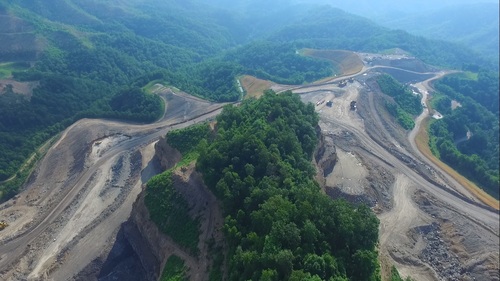
Announcing our newest Fellowship Team project!
Photo by Junior Walk
Read more about Public Lab Fellowship Teams here
The Project Issue: Mountaintop Removal Coal Mining in West Virginia
For well over a century the coal industry has exploited the people and natural resources of West Virginia. The technology they have developed over the past four decades specifically has allowed them to destroy and poison the environment to an almost unbelievable extent, all in the name of maximizing profit. Large scale surface mining, also known as mountaintop removal not only deforests thousands of acres per mine site, but completely destroys the landscape leaving behind only bare rock and rubble. The biologically diverse forests that used to set where these mines now exist can never be replaced, the topsoil that allowed them to exist is now buried under valley fills. The bedrock that once formed some of the oldest mountains on the planet is blasted apart and turned into toxic dust clouds that settle on the communities below.
The state regulatory agency, the West Virginia Department of Environmental protection has been in the pocket of the coal industry since its conception. This makes it difficult to hold the industry accountable to the relatively lax environmental laws, but not impossible. Over the years, Coal River Mountain Watch has discovered a handful of methods in the pursuit of chipping away at the profit margins of coal companies. One of the most successful tactics has been in observing, documenting, and monitoring mining activity and reporting on them to the DEP. The intent behind this fellowship team is to support our continued work against the coal industry using drones and other forms of observation to document violations of environmental law, and pressure the DEP to take appropriate action. The fines incurred by the coal company are a pittance and are factored into the cost of doing business.
The main goal of this work is to make the companies pull workers and equipment away from actively mining coal in order to fix the problems they created.
In this project, we aim to:
- Monitor active mine sites from the ground and via drone.
- Research environmental regulations and identify tactics that concerned citizens in communities around surface mines can use to document illegal actions and permit violations by the mining companies.
- Communicate our findings to the Department of Environmental Protection and follow up with them to raise the pressure on the agency to take action.
- Create a videos examining the state of abandoned and active mines in the area on and around Coal River Mountain, and describe the tactics that can be used to hold the industry accountable.
Community Organizing Fellow and Project Lead: Junior Walk

Junior Walk is an environmental activist who lives in Boone county West Virginia. Since 2009 he has worked with various anti-surface mining organizations in the Appalachian region. In that time his work has taken various forms, including lobbying on federal and state levels, gathering data for lawsuits against coal companies, and even getting arrested doing direct action on surface mines and corporate offices. Junior now serves as the outreach coordinator for Coal River Mountain Watch, a role in which he spends his time monitoring coal mines in his community for environmental violations, as well as educating people on the effects surface mining has had on the state of West Virginia.
Join this Fellowship Team!
This Fellowship team is seeking:
This fellow will join the team to work closely with the Community Organizing Fellow to document the project on PublicLab.org and produce videos with materials from the community.
- Commitment Period: roughly 6-8hr/week September - May
- Fellowship Stipend: $6,600USD in total over the commitment period.
- Where: This fellowship is open to anyone and is remote; phone in team meetings will be held on EST and be grounded in community efforts in West Virginia.
- Requirements for the position: This fellowship will require remote work abilities, comfortable working across diverse stakeholder groups, and strong communication skills (verbal/written).
An Environmental Policy Fellow
This fellow will join the team to 1) Investigate surface mining permits in West Virginia and create clear documentation around permit statuses. 2) Research state and federal environmental regulations in order to find new and innovative ways to hold the coal mining industry accountable. And 3) Identify tactics that concerned citizens in communities around surface mines can use to document illegal actions and permit violations.
- Commitment Period: roughly 6-8hr/week September - May
- Fellowship Stipend: $6,600USD in total over the commitment period.
- Where: This fellowship is open to anyone and is remote; phone in team meetings will be held on EST and be grounded in community efforts in West Virginia.
- Requirements for the position: This fellowship will require remote work abilities, comfortable working across diverse stakeholder groups, and strong communication skills (verbal/written).
Local Field Technician Fellows
These fellows will join the Community Organizing Fellow on short term basis in the field hiking and act as another set of eyes on the mine sites. These Fellows will also record observations and take photographic evidence of anything concerning around the mining sites.
- Commitment Period: 1 day
- Fellowship Stipend: $120USD per day out in the field (limited to 25 total stipends)
- Where: Raleigh/Boone counties in West Virginia
- Requirements for the position: This fellowship will require you to be able to hike through rugged mountain terrain both on and off a trail for anywhere between 2 and 5 hours. A willingness to hold the coal industry accountable to the bare minimum legal standard is a must.
If you're interested in joining the team as a Local Field Technician Fellow, please email junior.walk1337@gmail.com
Follow related tags:
drones coal-mining documentation aerial-photography
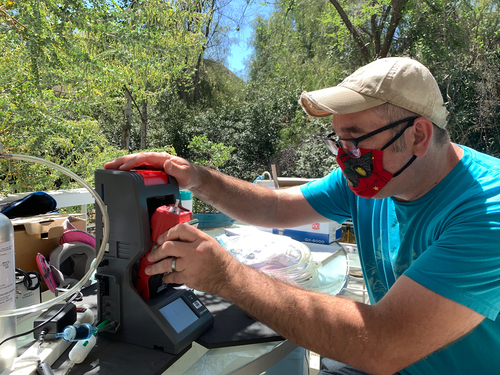
Gas-Calibrated Monitor Explainer
Haz click aqui para leer el contenido de esta página en español.
Gas-calibrated monitors are a class of air monitoring equipment that use canisters of known quantities of gas(es) to assess and ensure the accuracy of an instrument.

For example, if you have an air quality monitor that measures sulfur dioxide (SO2), you measure the operation of the SO2 sensor with a canister that has a lab-certified quantity of SO2. A gas-calibrated instrument is typically calibrated every 60-90 days, depending on usage. These instruments also need to be bump tested -- bump tests check the device's accuracy before each use. A dedicated calibration station is a must when using these instruments.

Through this technology, we are monitoring airborne:
- Hydrogen sulfide (H2S)
- Methane (CH4)
- Volatile organic compounds totals (tVOC)
- Isobutylene (C4H8)
- Carbon monoxide (CO)
- Oxygen (O2)
- Sulfur dioxide (SO2)
- Formaldehyde (CH2O)
- Ammonia (NH3)
Because the monitors are calibrated and bump tested regularly, they are highly accurate. Unfortunately, they are time-consuming, complicated, and costly, making them a challenging choice for community science AQ monitoring.

Additionally, because they are handheld, data collection requires personnel in the field to record data. These monitors have a photoionization lamp that gets hot and can overheat during hot summer temperatures. When the ambient temperature is too high, the instruments shut off automatically to protect them from overheating. They also do not have the ability to record GPS data, so geospatial mapping has been challenging. These are all problems we are working on minimizing and we welcome input from the Public Lab community.
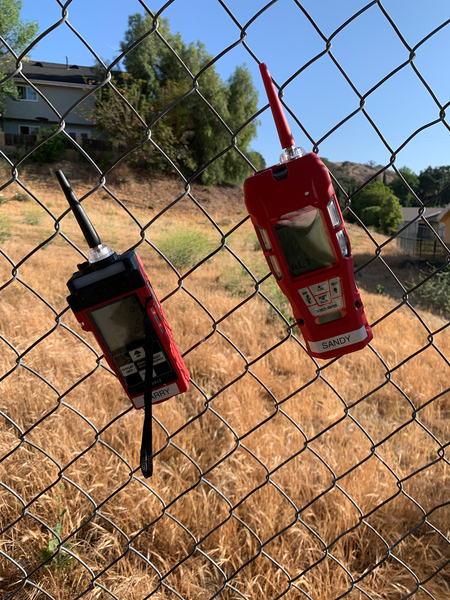
The benefit of using gas-calibrated monitors is that when they are serviced properly, you can accurately test for singular airborne pollutants.
As a side note, VVAMP is moving toward installing Purple Air sensors, as fire season is here in SoCal. Purple Air sensors do not monitor gases, but particulate matter. Follow our progress here!

VVAMP is monitoring ambient air gases adjacent to a massive landfill in Los Angeles County. The town of Val Verde is one of the communities affected by the proximity to the landfill. The Newhall Ranch community, which is currently in development, will also be affected. The issues with siting the landfill in this location are that it is located near a historic environmental justice community, and away from the population center of Los Angeles which it serves. The trucks that transport waste to the landfill from waste sorting facilities use diesel fuel that contributes to particulate pollution to communities sited near the I-5 and elsewhere. Los Angeles County has a county-owned, waste-by-rail facility that is permitted, yet unused. The county has instead relied on privately owned landfills for waste management.
Explicación sobre el monitor de Gas calibrado
Los monitores de gas calibrado son un tipo de equipo para monitoreo de aire que usa latas / bote / frasco de cantidades conocidas de gas o gases para evaluar y asegurar la precisión de un instrumento.

Por ejemplo, si tú tienes un monitor de calidad de aire que mide dióxido de azufre (SO2), tú mides el funcionamiento del sensor de SO2 con un frasco que tiene la cantidad de SO2 certificada por un laboratorio. Un instrumento de gas calibrado se calibra típicamente cada 60-90 días, dependiendo del uso. Estos instrumentos también necesitan una prueba funcional. Las pruebas funcionales verifican la precisión del dispositivo antes de cada uso. Una estación de calibración bien dedicada es una necesidad cuando se usan estos instrumentos.
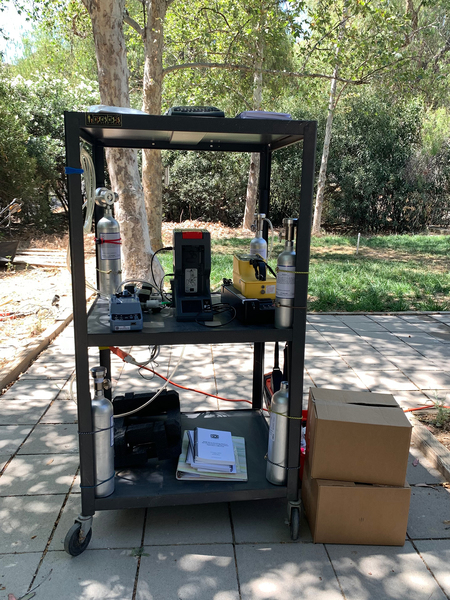
A través de esta tecnología, estamos monitoreando gases llevados por el aire:
- Sulfuro de hidrógeno (H2S)
- Metano (CH4)
- Totales de compuestos orgánicos volátiles (tVOC)
- Isobutileno (C4H8)
- Monóxido de carbono (CO)
- Oxígeno (O2)
- Dióxido de azufre (SO2)
- Formaldehído (CH2O)
- Amoníaco (NH3)
Porque estos monitores son calibrados y probados funcionalmente regularmente, son muy precisos. Desafortunadamente, consumen mucho tiempo, son complicados, y costosos, siendo una elección desafiante para la ciencia comunitaria de monitoreo de calidad de aire.
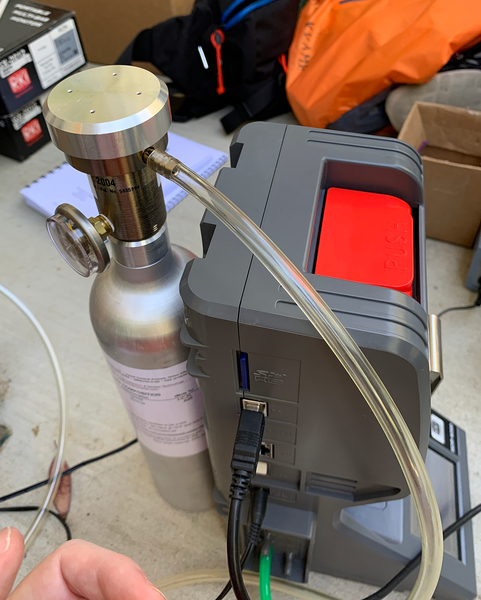
Adicionalmente, porque son portátiles, la colección de datos requiere personal de campo para recuperar y juntar los datos. Estos monitores tienen una lámpara de fotoionización que se pone muy caliente y se pueden sobre calentar durante las temperaturas calientes de verano. Cuando la temperatura ambiente es muy alta, los instrumentos se apagan automáticamente para proteger el equipo y evitar el sobrecalentamiento. Los instrumentos, también no tienen la habilidad de grabar puntos GPS, así que el mapeo geoespacial ha sido desafiante. Estos son los problemas que estamos trabajando para minimizar y estamos abiertos a sugerencias de parte de la comunidad de Laboratorio Publico.

El beneficio de usar monitores de gas calibrado es que cuando se preparan apropiadamente, tú puedes hacer testeos precisos para un contaminante llevado por el aire en específico.
Como nota aparte, VVAMP está avanzando con la instalación de sensores de "Aire morado", la temporada de incendios está acá en el sur de California. Sensores de "Aire morado" no monitorean gases, pero sí material particulado. ¡Sigue nuestro progreso acá!
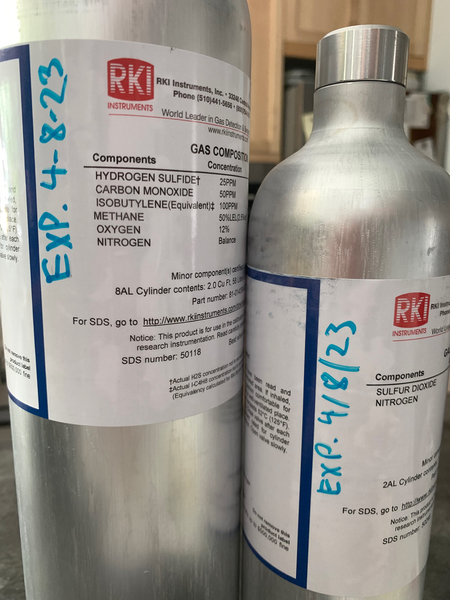
VVAMP está monitoreando gases en el aire del ambiente local adyacente a un relleno sanitario masivo en el condado de Los ángeles. El pueblo de Val Verde es una de las comunidades afectadas por la proximidad del relleno. La comunidad del Rancho de Newhall, que actualmente está en desarrollo, estará también afectada. Los problemas de la ubicación del relleno sanitario, es que está ubicado cerca de una comunidad histórica de justicia ambiental, y afuera de la población central de Los Ángeles a la que sirve. Los camiones que transportan desechos hacia el relleno sanitario desde las instalaciones de clasificación usan gasolina diesel que contribuye a la contaminación de partículas en las comunidades situadas cerca de la carretera I-5 y otras partes. El condado de Los Ángeles es dueño, y tiene el permiso para transportar desechos por ferrocarril, y aun así no se usa. El condado en vez depende de rellenos sanitarios de propiedad privada para la gestión de residuos.
Follow related tags:
air-quality air blog lang:es
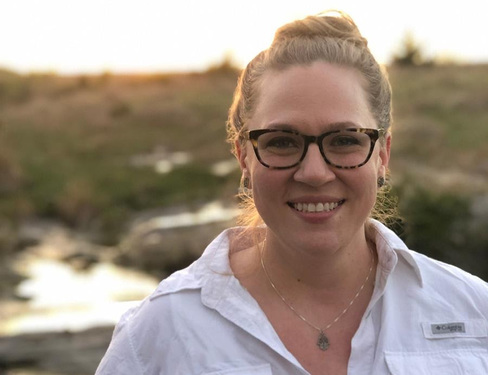
Welcoming Public Lab's new Executive Director
The Board of Directors of the Public Laboratory for Open Technology and Science (Public Lab) is very excited to announce its new Executive Director, Jordan Macha. She began her position in this role on April 19, and is succeeding Public Lab co-founder and founding Executive Director Shannon Dosemagen, who departed in 2020.
Macha brings deep experience in community building and leadership in the environmental justice field to Public Lab. In her recent position as Executive Director of Bayou City Waterkeeper, Macha helmed efforts with community partners on wetlands protection and clean water advocacy. As a founding member of the Coalition for Environment, Equity, and Resilience, her team partnered with community leaders and diverse organizations focusing on Hurricane Harvey and flood recovery in the Greater Houston area, encouraging the region to adopt equitable resiliency models to holistically serve its residents. Through her previous work with Healthy Gulf and the Sierra Club, Macha advanced coastal restoration and clean energy priorities across the Gulf region. She received her Master's of Public Administration with an emphasis on Coastal & Urban Water Management and Policy from Texas State University.
"I am honored to have the opportunity to lead the community and staff of Public Lab," says Jordan Macha. "Building on the tremendous momentum of the last eleven years, Public Lab is well-equipped to develop its vision to advance community science and empower knowledge producers to make positive change. I'm excited to join the incredible team of staff, volunteer leaders, and diverse community partners working to make impactful environmental change worldwide."
"The Public Lab Board of Directors is proud to welcome Jordan Macha to this leadership role at such a crucial moment for community advocacy to advance environmental justice," says Board of Directors chairperson Janet Haven. "Her career is proof of an unwavering support for the protection and empowerment of communities, and the board looks forward to Jordan's experience, passion, and leadership shaping the future of our work together."
Macha was influential in the Resilient Houston Plan in incorporating natural infrastructure and equitable nature-centered solutions into its Living with Water strategy, working to future-proof the region's water systems by improving its wastewater facilities and championing policies to protect wetlands and floodplains. She currently serves as the Harris County representative for the H-GAC Natural Resources Advisory Committee, and the environmental representative for the Texas Water Development Board's Region 3 Flood Planning Group. Partnering with Harris County, Jordan and her partners are working with county leadership to embrace an equity-centric and holistic approach to flooding, furthering the advancement of comprehensive, intersectional projects that put people over profits and embrace nature-based solutions.
Shannon Dosemagen notes of the announcement, "I'm thrilled to welcome Jordan to Public Lab. I believe she is the right person to lead the organization into its second decade, building on our legacy of supporting communities in using science and open technology to support their environmental goals."
Follow related tags:
nonprofit blog location:blurred place:united-states

Community Science in the Classroom
What is community science?
As a community science organization that purposefully democratizes science, Public Lab is uniquely positioned to support youth to become effective environmental scientists, stewards, and advocates. Public Lab defines community science as community-led scientific exploration and investigation to address community-defined questions, allowing for engagement in the entirety of the scientific process. Unlike traditional citizen science, Public Lab’s approach emphasizes local and traditional knowledge, community ownership of research, and working together in scalable networks to encourage collaborative learning and civic engagement. Intrinsic to this democratization is the necessary situating of environmental topics in their cultural and political contexts, accentuating the importance of realistic, relevant, and actionable study.
What does community science look like in a classroom?
Community science translates well into an educational context because young people are given a voice, platform, and level of consideration often absent in other aspects of their lives. Classroom community science projects are youth-led with an approach that emphasizes participant and community ownership of research, from question identification through analysis, and working together to encourage collaborative learning and civic engagement. After identifying their interests, students conduct research as they join the efforts of people and organizations already working on these issues and take the lead in aspects of study design, data collection, and analysis. The data collected from these student-designed projects supports community action and civic engagement.
Participating in community science projects benefits science learning by providing for many different kinds of roles within scientific activity, motivating underserved learners to participate in science, and engaging participants with scientific data in meaningful ways. In particular, opportunities to contribute to and lead work in a scientific or civic sphere, to take up the role of expert in relation to issues of community concern or opportunity, and to tailor one’s role within collective work to fit prior experiences, make community science a context for building a meaningful connection between students and science.
An educator who wanted to integrate community science principles into their practice might:
- Introduce a broad topic area and let student interest guide the direction of learning: when starting a unit on soil, ask students to name their concerns about the soil in their own backyards or on site at their school.
- Facilitate conversations about hyper-local environmental concerns: when talking about the global climate crisis, ask students what it looks like on a local level or how they experience the climate crisis in their everyday lives. Help students to build connections between local street flooding, increasing rain levels, and global changes in precipitation trends.
- Encourage students to respect their experiential knowledge and that of others: students can annotate maps with their local expertise, adding information that a satellite image or outside researcher could never bring to a project. When studying local issues, have students interview friends, family members, and teachers to learn more about how things have changed in their lifetimes.
- Connect in-classroom learning with community concerns: Local environmental justice groups, community associations, and grassroots organizers are often doing work that aligns with what your students are learning. You can use Public Lab’s geographic features to find people organizing in your area.
The chart below compares student activities and engagement throughout the scientific process when following community science principles versus traditional science education practices.
Examples of student work in the Public Lab community:
- Cancer Problems: Meet Cancer Alley
- The Problematic Pollution of Lake Pontchartrain
- Wateristic: an underwater bioluminescence detector
Leveraging Public Lab to bring community science into your classroom.
Public Lab’s online community and collection of research can be a resource for your classroom, connecting students to community members geographically or by project content. Public Lab’s website can be used as an online lab notebook for students to share their work as well as give and receive feedback.
Public Lab resources for getting started with community science in your classroom
- Getting Started: this webpage will help orient you to our online community. From this page, you can learn how to:
- Post a question using the Question & Answer forum.
- Post an Issue Brief to share about an environmental concern and reach out to others for ideas.
- Search methods for environmental monitoring ideas.
- Classroom Community Science Lesson Plans: An adaptable curricula for bringing student-led environmental projects into your classroom.
- Public Lab's main education page: see what other educators in our community are up to and get involved in the conversation.
This is part of a series for #EEWeek2021. To read more environmental education content, be sure to follow the Education tag.
Follow related tags:
education classroom blog community-science

Public Lab calls for the immediate removal of Richard Stallman
Statement from Public Laboratory for Open Technology and Science:
March 25, 2021
Public Laboratory for Open Technology and Science (Public Lab) condemns the inappropriate and dangerous behavior of Richard Stallman and his unqualified reinstatement to the Free Software Foundation (FSF) Board of Directors. Public Lab supports the statement written by Software Freedom Conservancy in September 2019.
As of Monday, 22 March 2021, the Free Software Foundation has reinstated Richard Stallman to the FSF Board of Directors. In light of Stallman's reinstatement, Public Lab renounces the award the organization received from the FSF in 2017.
While Public Lab has never received funding from FSF, as long as FSF allows Stallman to hold a leadership position within the foundation, Public Lab cannot in good conscience hold an award or foster a relationship with a foundation that condones Stallman's behavior.
Public Lab is deeply disappointed that FSF has not taken action regarding Stallman's inappropriate behavior. We are seriously concerned for the safety of our shared community, as Stallman's reinstatement signals that sexual harassment and sexual violence against women is tolerated by FSF. Their actions of reinstating Stallman's leadership may result in more women being exposed to this abhorrent behavior.
Public Lab calls on FSF to revoke their reinstatement of Stallman to their Board of Directors immediately. We encourage FSF to begin the process of rebuilding their trust within the free software community, in particular with the women and other individuals who look to FSF for integrity, safety, and leadership in this space.
To support this effort, you can join the collective call to action by signing onto this open letter calling for Stallman's removal from all leadership positions.
Follow related tags:
blog public-comment lat:42.360082 lon:-71.05888